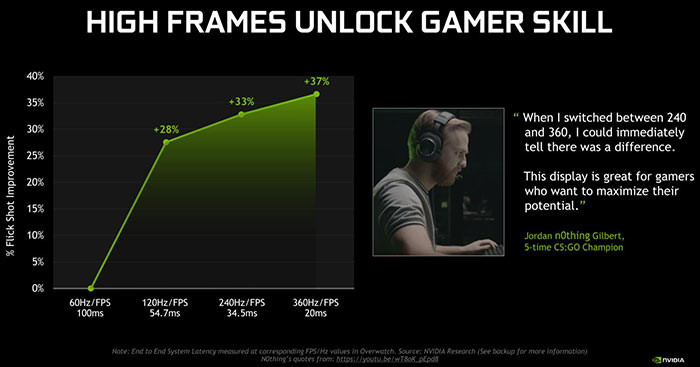At CES 2020 Nvidia is trumpeting the virtues of 360Hz refresh gaming monitors for eSports players. Spearheading this super fast refresh rate advance is a new monitor from Asus, whose full specs are yet to be shared - but we know the most of the headlining essentials.
The Asus ROG Swift 360Hz G-Sync display will be released later this year and sports a next generation panel from AU Optronics. What we know about the panel used at the time of writing is that it supports refresh rates up to 360Hz "for unparalleled smoothness, [and] lower system latency for faster reaction times". The only other spec we have at hand is that the display panel is 1080p and has a 24.5-inch diagonal. Obviously there are important specs missing: we would like to know such as the panel type, max brightness, colour reproduction metrics, and more.

If you take a look over the Nvidia blog post, the greatest thrust of it isn't about the new technology but rather working to convince readers that the extra fast refresh rate on offer here is a feature worth paying for. We are all familiar with the law of diminishing returns, but Nvidia is essentially saying in its blurb and linked studies that humans can see benefits in smoothness and latency up to 100Hz refresh.
In the video above you can see CS:Go champion 'nOthing' outing the prototype Asus ROG Swift 360Hz eSports display through its paces in his game of choice. A key quote is that "When I switched between 240 and 360Hz, I could immediately tell that there was a difference". A particular performance buff for the pro eSports gamer was felt in transferring targets.

Other popular eSports titles which could feasibly run at 360Hz on this monitors using beefy Nvidia GPUs include; Rainbow Six: Siege, Overwatch, and Fortnite.
As the benefits fo super-high refresh monitors aren't easily conveyed by mediums such as web pages and YouTube videos (as was the case with features like HDR and VRR) Nvidia has its suite of 360Hz demos at CES. Pricing and availability for the Asus ROG Swift 360Hz eSports display will emerge later this year, as it nears launch.






